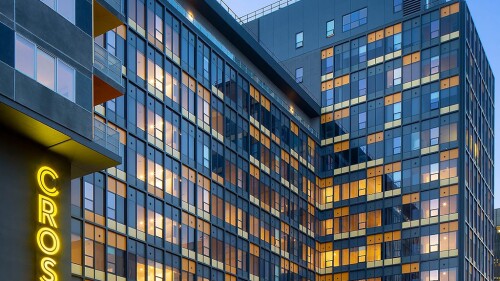The multifamily housing market—at least in Washington, D.C., and other top markets—is so rich with investment opportunity that “there are no bad strategies right now,” according to ULI member Alan W. George, chief investment officer for Equity Residential, and other multifamily industry leaders who spoke recently at ULI Washington’s Real Estate Trends Conference. At the same time, the multifamily industry panelists agreed that nothing lasts forever, and that windows of opportunity are closing fast.
One strategy, for example, is the acquisition of land for future multifamily development. George said that his company, a real estate investment trust, bought land last year and that the return on investment will be “unbelievable.” Panel moderator James Butz, a ULI member and president and CEO of Jefferson Apartment Group, said that his organization obtained a 9 percent return on a land investment made last year. But such rewarding plays will soon be a thing of the past, they pointed out, as the price of land in top markets is now skyrocketing.
How long will the good times roll? David Olney, senior partner and chief investment officer for Berkshire Realty Holdings, predicted that pent-up demand for multifamily rental housing will last another three to five years. Grant Montgomery, a ULI member and vice president of Delta Associates, offered a different opinion, saying: “We’re not overbuilt right now, but the pipeline is picking up. In the Washington, D.C., region, we have cut the apartment deficit in half in just two quarters, and we could reach break-even by the end of this year.” George weighed in by predicting two years of continued strong growth for multifamily housing in top markets, based on job growth and constrained supply.
So, are the top markets getting overheated? Are cap rates too low? George said yes, cap rates are very low, but the high prices for multifamily assets are offset by the potential for rent growth. “There’s a flight to quality,” he noted. “The new value-add is market recovery.” And while low cap rates will continue to apply to Class A core assets, a “wave” of distressed assets with much different valuations is expected to hit the market over the next few years.
While most of the multifamily panel’s discussion focused on the investment angle, the panel also addressed the types of multifamily communities and developments that are achieving market acceptance. Adding a retail component to transform an apartment building into a mixed-use community used to be considered risky; now it is the norm. “We love retail and have almost 1 million square feet [93,000 sq m] of it,” said Equity Residential’s George. “This retail space stayed 95 percent occupied throughout the recession because it serves the residents of our buildings.”
Delta’s Montgomery agreed. “You have to offer ground-level retail now, and not just a drycleaner; renters expect it,” he said. Furthermore, he went on, “it’s not just the on-site amenities that matter to renters, but also the surrounding area. People want a high walk score and a ‘hip’ neighborhood with an active nightlife.” Another important trend in consumer demand is smaller living units coupled with more space and amenities in common areas.
In addition to enhanced amenities, people expect their buildings to be “green,” panelists noted. There are no quantifiable data showing that people will pay more for a green building, but today’s renters will choose a green building over one that’s not so green, commented Montgomery and George. George went further, stating that sustainability can be highly profitable for multifamily building operators. “We do about 5,000 rehabs a year, and always use this opportunity to install sustainable features such as dual-flush toilets, programmable thermostats, and LED lights,” he said. “Replacing incandescent bulbs with long-lasting fluorescents that almost never have to be replaced provides huge labor cost savings—it’s a no-brainer.”




